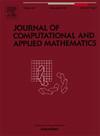High-order multiscale hybridizable discontinuous Galerkin method for a class of one-dimensional oscillatory second-order equations
IF 2.6
2区 数学
Q1 MATHEMATICS, APPLIED
Journal of Computational and Applied Mathematics
Pub Date : 2025-09-09
DOI:10.1016/j.cam.2025.117047
引用次数: 0
Abstract
In this paper, we propose and analyze multiscale hybridizable discontinuous Galerkin (HDG) methods for solving a class of second-order equations with oscillatory solutions in one dimension. The high-order multiscale finite element spaces and contain non-polynomial basis functions that incorporate fine-scale features, as developed in our previous work (Dong and Wang, 2020). We prove that the resulting multiscale HDG method with the space achieves optimal convergence in both the primary variable and its derivative with respect to the mesh size , provided is sufficiently small. Numerical experiments demonstrate that for both and spaces, the multiscale HDG methods exhibit second-order convergence without any resonance errors even when is comparable to or larger than the wavelength scale, whereas the traditional HDG method with polynomial basis functions fails to converge in this regime. When is smaller than the scale of the wavelength, numerical results confirm the optimal high-order convergence predicted by the error analysis. Our numerical results also demonstrate that the proposed methods are capable of capturing highly oscillating solutions of the Schrödinger equation in the application of the resonant tunneling diode (RTD) model.
一类一维振荡二阶方程的高阶多尺度杂化不连续Galerkin方法
本文提出并分析了求解一类一维振动二阶方程的多尺度杂交不连续伽辽金(HDG)方法。高阶多尺度有限元空间Ep和T2p+1包含包含精细尺度特征的非多项式基函数,如我们之前的工作所开发的(Dong和Wang, 2020)。我们证明了所得到的具有Ep空间的多尺度HDG方法,在h足够小的条件下,主变量及其导数对网格尺寸h都达到了最优收敛。数值实验表明,对于Ep和T2p+1空间,当h等于或大于波长尺度时,多尺度HDG方法表现出二阶收敛性,没有共振误差,而传统的多项式基函数HDG方法在该范围内不能收敛。当h小于波长尺度时,数值结果证实了误差分析预测的最优高阶收敛性。我们的数值结果还表明,所提出的方法能够在谐振隧道二极管(RTD)模型的应用中捕获Schrödinger方程的高振荡解。
本文章由计算机程序翻译,如有差异,请以英文原文为准。
求助全文
约1分钟内获得全文
求助全文
来源期刊
CiteScore
5.40
自引率
4.20%
发文量
437
审稿时长
3.0 months
期刊介绍:
The Journal of Computational and Applied Mathematics publishes original papers of high scientific value in all areas of computational and applied mathematics. The main interest of the Journal is in papers that describe and analyze new computational techniques for solving scientific or engineering problems. Also the improved analysis, including the effectiveness and applicability, of existing methods and algorithms is of importance. The computational efficiency (e.g. the convergence, stability, accuracy, ...) should be proved and illustrated by nontrivial numerical examples. Papers describing only variants of existing methods, without adding significant new computational properties are not of interest.
The audience consists of: applied mathematicians, numerical analysts, computational scientists and engineers.

 求助内容:
求助内容: 应助结果提醒方式:
应助结果提醒方式:


